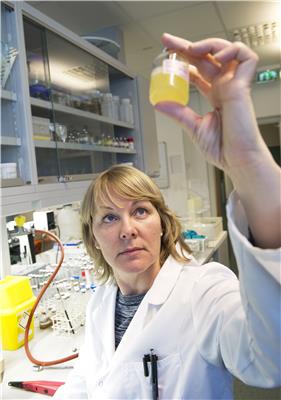| Online: | |
| Visits: | |
| Stories: |

| Story Views | |
| Now: | |
| Last Hour: | |
| Last 24 Hours: | |
| Total: | |
Bacteria Method for More Effective Oil Recovery
If the bacterium can do this by ‘selective plugging’ down in the sandstone beds below the North Sea, existing oil reservoirs can be exploited more effectively.
Senior researcher Gunhild Bødtker and her colleagues at Uni Research CIPR are the first to examine whether this method of microbially enhanced oil recovery
Photo credit: Marit Hommedal
Bødtker and her microbiology group will start by testing the soil bacterium in the biology block at Marineholmen in Bergen.
The new research is part of a three-year project with a budget of around NOK 15 million, funded by the Petromaks 2 programme in the GOE-IP research council. The idea and the theoretical basis for the technology were developed by Gunnar Sjetne, Gregor Olaga and Asle Ravnås in the period 1999–2004.
Uni Research CIPR is an independent research partner in the project entitled ‘Microbial water diversion technology for enhanced oil recovery in sandstone and carbonate reservoirs’.
The bacteria grow and multiply
A common recovery method on the Norwegian continental shelf is to pump sea water into the reservoirs to force out more oil.
Bødtker and her colleagues previously showed, through a Statoil-financed research project, that marine bacteria grow and multiply in the oil-water contact that occurs in the reservoir rocks.
The effect is similar to what happens with soap: surface tension between oil and water is reduced and oil that was ‘caught’ in the reservoir formation comes out.
“Adding oxygen and nutrient salts to the injected sea water stimulates the growth of bacteria and more oil is released, or produced if you will,” says Bødtker.
This technique has been in use in the Norne field since 2001. In the new project, Gunhild Bødtker proposes to examine whether a soil bacterium can act as a sealant to divert the injection water away from the largest pores in sandstone reservoirs.
It is precisely these largest channels that the water naturally flows into, and that is where the oil is first pushed out of the reservoir.
Plugging the right places
The challenge is to prevent the water from continuing to flow into the large pore structures in the reservoir, Bødtker explains:
“If the bacteria are able to plug the right places, the water will go another way, into smaller pores where there may still be a lot of oil to force out. The whole idea behind this technique is selective plugging, whereby the bacteria only grow in the ‘waterways’ where there are large pores with no oil in them. Where there is a lot of water, the bacteria will find plenty of nutrients, and they can grow and form robust plugs of biofilm,” she says.
Water flows change
The idea is that new plugs will gradually form as the water flows in the reservoir change.
“This is an adaptive factor that differentiates this plugging method from other techniques,” Bødtker goes on.
As the name suggests, the soil bacterium does not normally live in water or in oil reservoirs. This may be both an advantage and a drawback, says the senior researcher at Uni Research CIPR:
“We add a carbon source to the injection water, a substrate that not many bacteria grow on. But we do not know for sure whether the soil bacterium will have to compete for food with other bacteria from the sea water, and we also need to study in more detail how much biofilm is produced, how strong it is and whether it is correctly positioned in the reservoir to give the desired effect,” says Bødtker.
As the researchers are testing a new microbial technology, Bødtker stresses the importance of designing correct and effective tests.
“The tests have to take account of relevant problems from a technically objective standpoint. That is very important if we are to actually discover whether the technique can work in the field,” she says.
Initial tests in the laboratory
The first step is to study the bacterium in an ‘ideal system’ in the lab in Bergen.
“When we know whether the technology delivers what it promises, it can be tested in a more complex system. In the lab, before we can talk about testing in reservoirs in the North Sea, we aim to identify what is relevant to implementation in the field. We are very curious to find out how whether this works,” says Bødtker.
Another, smaller, part of the project aims to test plugging with particles, to seal up larger fractures in limestone reservoirs.
“For this part of the project, we need a different type of plug, where it’s a matter of transporting particles into reservoirs,” says Bødtker.
In this technology too, bacteria play a key role in positioning the plug correctly.
Microbial methods implemented:
MEOR: Norne 2001 and Statfjord 2005
Nitrate treatment: Tested on Veslefrikk and Gullfaks in 1999, later implemented on Norne and Statfjord on the Norwegian continental shelf and on a number of other fields around the world.
Nitrate treatment to prevent reservoir acidification: Nitrate is added to the injection water to prevent salt-reducing bacteria (SRBs) from forming the toxic and corrosive gas H2S (‘bad egg gas’).
Nitrate stimulates the growth of nitrate-reducing bacteria (NRBs), which produce nitrite which is toxic to SRBs. The method has proved more effective than using poison against SRBs, and is a good example of green technology in the oil sector.
Contacts and sources:
Uni Research
Source: http://www.ineffableisland.com/2015/06/bacteria-method-for-more-effective-oil.html




